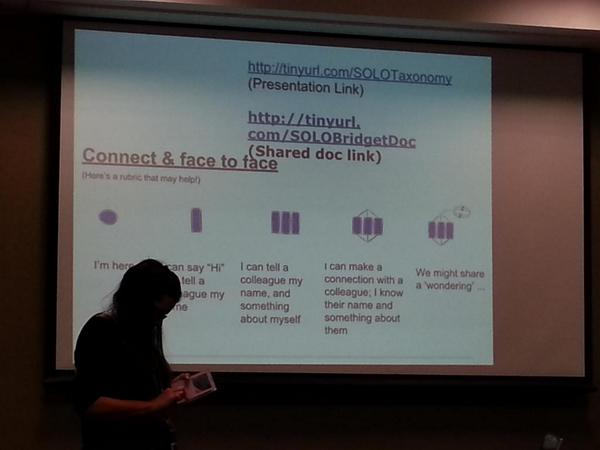
The irony captured in the above image is LOUD, I love it because I learned from it, and there are no prizes for guessing who I was 'connecting' with. This was the message I am sending in the picture above...
I can now look at that with a grin and think - yep, I was scared and it felt disruptive, but most things that are worth anything in this world seem to be so.
It is taking me a while to get through the questions (ERO, planning, reports etc are also visible!) I was so fortunate to have Pam @arti_choke attend the 'party' on the day and be present to share her knowledge; providing answers to many questions. Smashing barriers - seriously you can leave the walls (they connect the roof and floor rather well), we can work through them!
Sharing and crediting are only two of the very important messages I have learnt from Pam.
So, I thought I would begin posting some of the Q's I was asked and the A's I have shared.
Anyone can access the whole doc at any time - link is on the presentation. http://tinyurl.com/SOLOTaxonomy
I have felt it before - "I want to ask, but I don't want to seem silly!" regardless of how often the speaker says "No question is a silly question/if you want to know, others do too..."
I'm so glad the awesome educators who shared breakout one with me asked. Kids do!
We are all learning and it should be shared...
- In your experience how does making learning visible through SOLO levels (hand signs symbols terms) engage and motivate five year olds to learn?
I think understanding the levels of SOLO is made more accessible by the use of the hand signals and the symbols. Multiple exposure and reference is important so they are able to notice the ‘connections’. Referencing SOLO across the learning areas helps them to notice that it is a tool that can be applied to many (and any) learning context. We do simplify it, but we also use the correct vocab - it breaks down barriers and offers opportunities for more to engage and develop understanding. ‘Prestructural is like I need help, or I don’t know, Unistructural is like I might know one thing about it, identify, define it, Multistructural is like I might know/can say/demonstrate more than one thing (NOT 3), describe it, Relational is like I’m ‘linking my thinking’, making connections, explaining, comparing, sequencing… Extended Abstract is like I’m throwing my learning out there - into a new situation, looking at it in a new way, doing something with my learning like teaching someone else about it, looking at it overall - generalising, creating, evaluating… For 5 year olds (and myself with my goals!) - looking at an aspirational goal like ‘I want to be able to write a story, read a book, swing across the monkey bars, can seem insurmountable, but a very next step towards it is manageable. And they get to experience and celebrate success as they move towards the goal - it’s visible, and motivating.
- The one thing that worries me about using SOLO with students is when students think “they are” extended abstract - the SOLO level represents them - much like kids say - “I am gifted” or “I am dumb” - reinforcing a fixed mindset. How do you address this with 5 year olds - so that they see that the SOLO level is related to the work sample - the learning outcome at that moment in time? It is all about the learning outcome and figuring out the next steps - it is never about the human being who is far too complex and entity to be represented by three sticks.
I certainly understand this and completely agree - the whole person is so important. Perhaps one of the things I love most about using SOLO is that it should always be used to measure the learning, never the learner. I do find that I need to explicitly teach this though. I find my learners, once they learn something, love to say ‘Oh that is easy!” Thus sometimes discrediting others who may be still trying to master the skill. I question; “Did you always find this easy? Was there a time you couldn’t do this?” Going back to ‘when you were a baby could you…’ seems to work well! I have to work to reinforce the growth mindset, because the fixed mindset seems to develop far more easily!
I can think of many examples of when asked to try something, my learners (and sometimes I) revert to “I can’t”.
Draw a picture of yourself “I can’t”
Write your name “I can’t”
...Present on Sonya’s TeachMeetNZ “I can’t! Wait… Can I?”
To reach ‘I can’ - you only have to take one next step, then the next...; draw your head, write the initial letter or in my case, login and download the template… :-)
It’s learning. It’s something we can all do. Success is important to acknowledge and celebrate. Through effort - they (and we) earn it and it should be celebrated and enjoyed.
This is a collection of the tweets shared by a wonderful group of educators who joined the breakout.
https://storify.com/arti_choke/bridget-casse-making-the-most-of-the-early-years
@vanschaijik captured this one too - thank you. My Twitter PLN is remarkable.


No comments:
Post a Comment